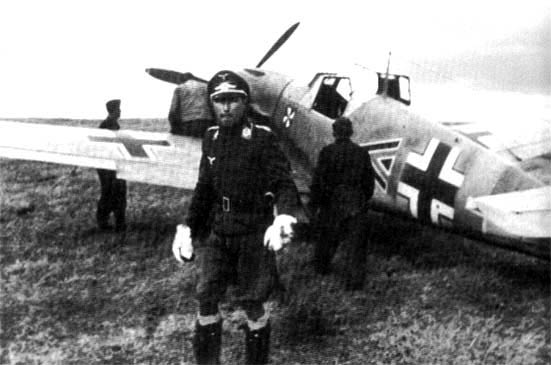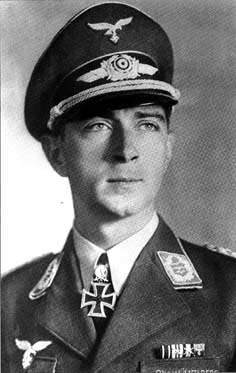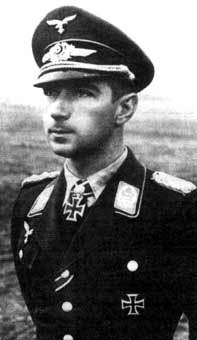


Photo: Ch.Bergstrom A.Mikhailow; Black Cross Red Star, vol.1, Pacifica Military History
Above - oberst Werner Vati Mölders, the inspector of the Luftwaffe Figter Arm, returns from one the unnoficial combat sorties that he undertook with III./JG 77 over the Crimea in November 1941. As is cleary shown in this unique photo, exiting Mölders wears no military awards whatsoever - even though he was the most decorated Wehrmacht serviceman at that time. As a reaction to the persecution of the opposition to the Nazi regime within the Catholic Church during the Fall of 1941, Mölders declared that he refused to carry the insygnias of this heinous regime. After some historicans, the fatal crash of He 111 on 22 November 1941 with Mölders on board wasn't an accident...
In text two another photos of Mölders, with decorations yet...
The attack of Germany on The Soviet Union planned as The Operation ‘Barbarossa’ began on 22 June 1941. As a support for the powerful invading forces 2800 Luftwaffe aircraft were dispatched..The Group of Army ‘Mitte’ was supporterd by Luftflotte 2, directed at that time by Generallfeldmarschal Albert Kesselring, and it included Fliegekorps II and VIII. Their duty was not only securing their own bombers, but first of all to win the advantage in the Russian sky.
 The commander of
Jagdgeschwader 51 was then the most efficient pilot of the
Luftwaffe Oberstleutnant Werner Mölders. Together with his
squadron he was staying at the airport of Stara Wieś in Eastern
Poland, and all of his unit had a modern equipment consisting of
modern fighters Messerschmitt Bf109f. Mölders, born on 18 March
1913 in Gelserkirchen was at that time a living legend of German
airforce. He appeared to be a phenomenal tactitan and introduced
in Luftwaffe a four-aircraft fighting sequence, where two pairs
of aircraft secured each other during an air fight. This gave the
German pilots tactical advantage on the battlefield for the first
three years of war. His first successes were accounted during the
civil war in Spain by shooting 14 republican aircraft of the
Russian construction. His score in the WW II was opened on 20
September 1939 during a fight near Merzig on the German-French
border, and by the day of the German offensive in the West he had
already 9 victories During the fight which took place at
Campiegne, France, on 5 June 1940 at Mölders, he being then the
commander of the III/JG 53, he was shot down and was taken
captive for three weeks. At the battle of Britain, as the
commander of JG 51, his scoring was increasing fast and on the 1
December he gained the 55th victory by shooting down
near Ashford a Hurricane of 253 Squadron. During five month
fights over Western Europe in 1941 Werner Mölders claimed
shooting down of additional 13 British fighters so that when
attacking the Soviet Union he had scored 68 victories in the air
and his neck was decorated with a Knight’s Cross with Oak
Leaves.
The commander of
Jagdgeschwader 51 was then the most efficient pilot of the
Luftwaffe Oberstleutnant Werner Mölders. Together with his
squadron he was staying at the airport of Stara Wieś in Eastern
Poland, and all of his unit had a modern equipment consisting of
modern fighters Messerschmitt Bf109f. Mölders, born on 18 March
1913 in Gelserkirchen was at that time a living legend of German
airforce. He appeared to be a phenomenal tactitan and introduced
in Luftwaffe a four-aircraft fighting sequence, where two pairs
of aircraft secured each other during an air fight. This gave the
German pilots tactical advantage on the battlefield for the first
three years of war. His first successes were accounted during the
civil war in Spain by shooting 14 republican aircraft of the
Russian construction. His score in the WW II was opened on 20
September 1939 during a fight near Merzig on the German-French
border, and by the day of the German offensive in the West he had
already 9 victories During the fight which took place at
Campiegne, France, on 5 June 1940 at Mölders, he being then the
commander of the III/JG 53, he was shot down and was taken
captive for three weeks. At the battle of Britain, as the
commander of JG 51, his scoring was increasing fast and on the 1
December he gained the 55th victory by shooting down
near Ashford a Hurricane of 253 Squadron. During five month
fights over Western Europe in 1941 Werner Mölders claimed
shooting down of additional 13 British fighters so that when
attacking the Soviet Union he had scored 68 victories in the air
and his neck was decorated with a Knight’s Cross with Oak
Leaves.
On 22 June 1941, with the first rays of the rising sun Bf 109F of JG 51 raised to fly from the landfield Stara Wies. About 6 a.m. eight Bf109F had a fight with four Russian fighters, where Oberstleutenant Mölders shot down one Curtiss. German pilots used this expression for the two-winged fighters Polikarpow I-153 Chayka. Probably his victim was the aircraft of lieutenant Gieorgij Chidov of 123 IAP from mixed 10 ShAD. After the first mission the JG 51’s pilots came back to their airfield and they only managed to have their breakfast when they were roused by anti-aircraft alarm. Russian aircraft were approaching. After Luftwaffe’s first attacks the Russians sent their own bombers to attack the German airfields. JG 51’s pilots took off hurriedly to meet near Brest small Russian groups flying without any fighter cover. Massacre began. Russian aircraft fell down one by one. Oberstleutnant Mölders shot down two Tupolevs SB-2 having now an account of 71 wins. But that was not the end of his successes that day. Just before noon another wave of Russian bombers appeared, now flying in groups of 20 or more aircraft. Also now Mölders scored two bombers SB-2. JG 51 claimed shooting down 69 Russian airplanes altogether that day, of which five were shot by their leader.
In the first days of warfare in Russia German pilots claimed an unbelievable amount of shot-downs – for instance on 22 June Luftflotte 2 claimed shooting down 210 enemy aircraft in the air and destruction to further 528 on the ground. Generally on the first day the Luftwaffe’s score was 322 Russian aircraft shot down and a further 1489 destroyed on the ground – 1811 aircraft altogether! The next day the destruction to further 775 machines of Soviet Air Force mainly on the ground was claimed. In the next days the warfare in the air was very fierce. Apart from providing support to their own bombers and ground forces, the JG 51 pilots often had to resist attacks by Russian bombers. In such circumstances over the German armor’s head Oberstleutnant Mölders shot down a Tupolew SB-2 bomber on 24 June, and the next day he sent one more machine of that type to the ground. On the 29 June morning, during another flight as the cover of the advancing armor column, four Bf109F of Stab JG 51 attacked a group of Russian bombers Pietlakov Pe-2. In two attacks Mölders shot down one of them thus obtaining his 76th victory. On that same day in the afternoon a formation of bulky fighters Polikarpow I-16 familiar to him from Spain was taken over. These machines were very maneuverable, but apart from that they could not surprise the German pilots with anything; now one of them fell victim to Mölders.
On 30 June the Messerschmitts Bf109F of JG 51 were perfectly directed on a great formation of Russian bombers flying without a fighters cover near Minsk. During a huge air fight Mölders’ pilots claimed shooting down as many as 114 enemy aircraft, and one of these shot-downs apeared to be JG51’s thousandth victory. That was only 20 shot-downs less than was the claim of this unit for the whole September 1940 in the Battle of England! Mölders himself shot down five Tupolevs SB-2 raising his score to 82 victories. In such a way he came to a level with a German ace of WW I Manfred von Richthofen, and for that Hitler awarded him with Swords to the Knight’s Cross with Oak Leaves.
The moving forward German forces pushed the Russian units ever further east. Lithuania and Latvia were taken and Estonia was entered, while several Russian armies were surrounded near Minsk and destroyed. The Red Army was withdrawing on the whole front.
Meanwhile, staying from 1 July at Stary Bychov airfield, Jagdgeschwader 51 was still effectively fighting the opponent’s air forces. On 5 July, to the north of Minsk, a group of six bombers Tupolew SB-2 was taken over and all of them were shot down within two minutes. Two of them fell victim to Mölders, who five hours later sent to the ground burning with flames two I-18 fighters, also known as Yakovlev Yak-1. Four days later, in one air fight, he claimed two Curtiss (I-153) and one I-16 shot down. The next day during his ‘Freie Jagd’ he got a lone two-winged reconnaissance Polikarpov RZ, which he shot down easily. Twenty minutes later another RZ appeared, and that one faced the predecessor’s fate, too. Mölders’ account increased to 91 victories. On 11 July he had two more kills, and still one more the day after. He was ever closer to the magic number of 100 victories – something never before achieved by anyone. Whereas on 12 July JG 51 claimed the 500th victory on the eastern front and the 1200th in their history.
 Oberstleutnant
Mölders was now taking off to fight several times a day. The
waiting of the whole unit for the ‘’hundred’’ became an
obsession. JG 51 leader broke the record of von Richthofen by
far, and the new record was at hand. Everyone waited for the
leader’s return and watched if he waved his wings flying over
the airfield, which was the agreed token of a victory. On 13 July
Mölders’ Messerschmitt waved the wings three times. The last
victory of that day he had before the whole personnel’s eyes,
when he shot down a bomber Pietlakov Pe-2 over the base. The next
day two more machines of that same type went in flames to the
ground, and his account reached 99 victories.
Oberstleutnant
Mölders was now taking off to fight several times a day. The
waiting of the whole unit for the ‘’hundred’’ became an
obsession. JG 51 leader broke the record of von Richthofen by
far, and the new record was at hand. Everyone waited for the
leader’s return and watched if he waved his wings flying over
the airfield, which was the agreed token of a victory. On 13 July
Mölders’ Messerschmitt waved the wings three times. The last
victory of that day he had before the whole personnel’s eyes,
when he shot down a bomber Pietlakov Pe-2 over the base. The next
day two more machines of that same type went in flames to the
ground, and his account reached 99 victories.
On the morning of 15 July 1941 Oberstleutnant Mölders divided tasks between his staff, and before noon he took off for a routine patrol flight. To the south of Orsha he saw five fighters Polikarpow I-16, which he attacked with his wingman. After a quick attack from the sun side the shot I-16 caught fire and went in a spin to the ground. The remaining Russian fighters dispersed in a blink. Mölders flied around a little receiving congratulations from his colleagues, who on the airffield radio heard his claim of the ‘’hundredth’’ and the wingman’s confirmation. On his way back he met a lone bomber DB-3, which he immediately attacked and shot down. In this way he gained his 100th and 101st victory as the first pilot in the world. At the Stary Bychov airfield great enthusiasm reigned: all pilots and mechanics gathered in the take-off area. When the JG 51’s leader’s Messerschmitt landed, champagne and other drink bottles shot, and Mölders was carried out of his cockpit on the people’s hands. They celebrated till the break of dawn.
At the news of Mölders’ success the chief commander of Luftwaffe Reichsmarschall Hermann Göring called him to Berlin, where Adolf Hitler granted him with Diamonds to the Knight’s Cross with Oak Leaves and Swords as the first Wehrmacht soldier. On 19 July he left the leadership of JG 51 at the hands of the so-far-leader of IV/JG 51, Major Friedrich Beckh, and took the office of Inspektor der Jägdflieger. This office entitled him to take care of fighter units and to represent them in front of Goring. Mölders came back to the eastern front at the beginning of September 1941. Most often he could be seen at the advanced commanding post at Chaplinka airfield, where to he flew in his Fi156 Storch and personally directed German pilots on groups of Russian planes. His radio nickname ‘Bussard’ was known on both sides of the front. Not totally confirmed information has it that Mölders still took part in combat missions on the eastern front and within two months he shot down about 30 more Russian machines. However, that was not noted anywhere as he was forbidden by Göring himself to participate in missions.
In the fall of 1941 the German advance to the East was stopped and all Wehrmacht faced the Russian winter. Mölders, having problems with provisions for his units, planned to appear in Berlin. They lacked everything: fuel, ammunition and spare parts. The fighter units on the eastern front had a serious crisis. In the meantime the Reich’s minister of arms Ernst Udet commited a suicide and Göring called Mölders to Berlin for Udet’s funeral. On the morning of 22 November 1941 Werner Mölders took off as a passenger from Chaplinka airfield onboard a He111 moving west. The flight was in a heavy rain and extreme atmospheric conditions. Near Breslau (Wrocław) one of the Heinkel engines stopped. In spite of the storm and thunders the Germans flew on until the other engine of He111 failed and the machine crashed into the ground, with Generall Werner Mölders dying in the wreck of the airplane. Thus one of the most excellent pilots of Luftwaffe fell.
Altogether, he performed about 300 combat missions, having claimed kills of 101 enemy aircraft in WW II and 14 in Spain. In his honor JG51 was given the name of ‘Mölders’.
Bf 109 F-2 of Werner Mölders, Stab/JG 51, summer 1941. It was probably in this aircraft that he, in aerial combat on the Eastern Front, on 15 July 1941, became the first fighter pilot to reach the magical number of 100 aerial victories.

2001.06.07, © WW II Ace Stories.